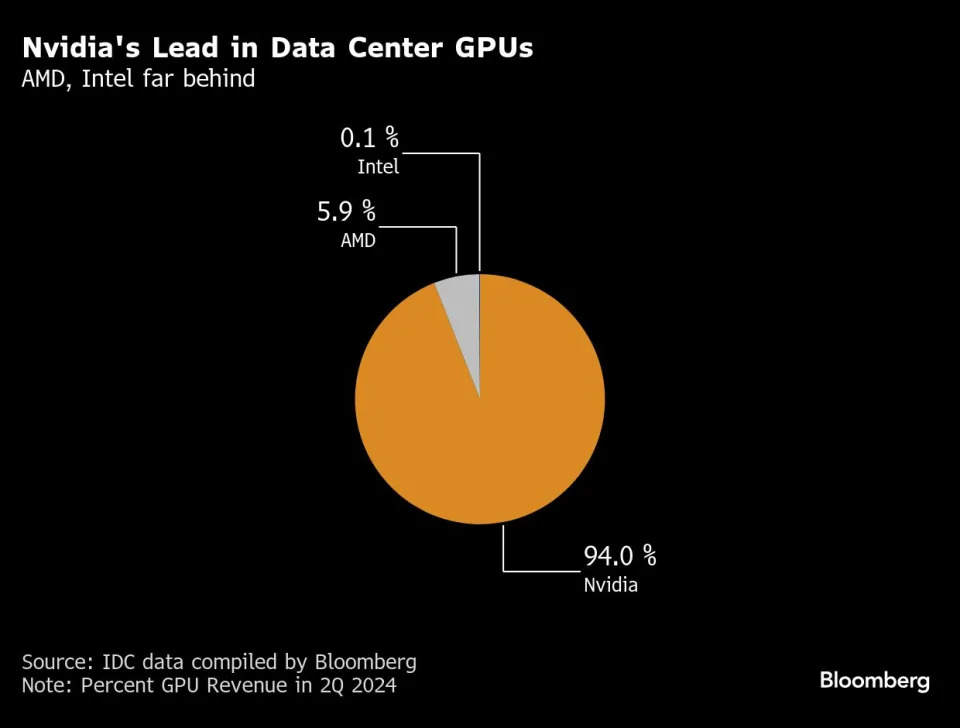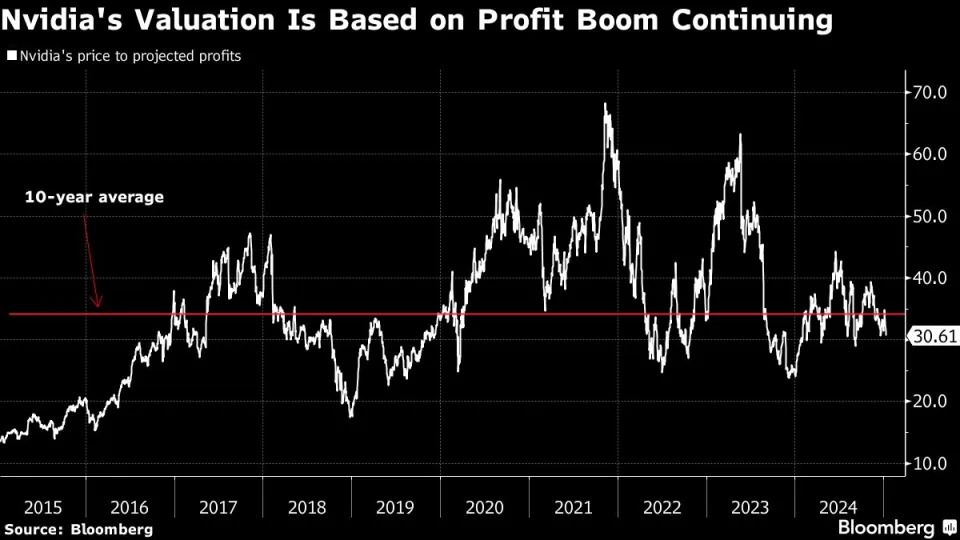Nvidia’s $3 trillion rally is on edge, Wall Street is unfazed
(Bloomberg) — Nvidia Corp.’s ( NVDA ) $3 trillion run-up in market value in the two years since ChatGPT helped trigger an AI frenzy is bigger than any stock rally in history in such a short time span. But the landscape is now changing for the chipmaker.
Competitors and customers are stepping up efforts to take a bigger slice of the artificial intelligence chip market. The sector’s blistering revenue growth is slowing. The Biden White House is looking to limit the sale of Nvidia’s most-advanced chips abroad, although it’s unclear how President-elect Donald Trump’s incoming administration will handle that.

Sounds scary? None of these risks are deterring investors from betting that Nvidia’s rally could add hundreds of billions of dollars more in market value in 2025 as the deluge of spending on AI computing keeps gaining steam.
“I’m not concerned we’ve seen a peak in Nvidia,” said Kevin Mahn, chief investment officer at Hennion & Walsh Asset Management. “There’s more growth to be had, although we should also see more volatility. The AI revolution is going to be a long road with a lot of potholes.”
That turbulence has been on display recently, with Nvidia shares slumping after a presentation by Chief Executive Officer Jensen Huang fell short of investors’ high expectations. The stock has dropped for five-straight sessions, shedding 12% since hitting a record on Jan. 6.
Investors say these kinds of swings come with the territory.
“Nvidia’s stock is always going to be way more volatile than the market,” said Joanne Feeney, portfolio manager and partner at Advisors Capital Management, which raised its price target on the shares earlier this week. “We see it as having multiple years of well-above average growth in earnings, and we do see that as explaining and sustaining the valuation.”
Nvidia shares are projected to rise 32% over the coming year, according to the average of analyst price targets compiled by Bloomberg. That would give the chipmaker a market value of more than $4 trillion, potentially dwarfing its closest peers Apple Inc. and Microsoft Corp. Its revenue is expected to hit $129 billion in its current fiscal year, which ends Jan. 30, up from $27 billion two years ago.
That said, there are plenty of potential hazards ahead. Here’s a look at the biggest issues Nvidia faces in the coming year:
AI Spending
Nvidia’s rally ultimately depends on demand for AI services. Nearly half its revenue comes from a handful of tech giants who are rushing to add computing capacity. Capital expenditures by Microsoft, Amazon.com Inc., Alphabet Inc. and Meta Platforms Inc. are projected to hit a combined $257 billion in the current fiscal year, up from $209 billion in 2024. Of course, those plans could change if the companies and their customers aren’t generating the big sales they expected from AI.

“At some point we’re going to need to see new applications drive revenue acceleration for other companies for this investment to continue,” said Gil Luria, head of technology research at D.A. Davidson and one of only eight of 78 analysts tracked by Bloomberg who doesn’t have a buy rating on the shares.
Outside of hardware makers like Nvidia, the most visible AI revenue growth is coming from the big web services providers like Amazon, Google Cloud and Microsoft’s Azure. However, it’s still a relatively small amount compared with how much the companies are spending on developing the technology.
So far, few of the tech giants’ cloud computing customers are seeing significant revenue growth from AI. Salesforce.com Inc. shares have rallied on high expectations for new AI offerings, but the customer relationship management software company hasn’t seen much of a sales boost yet. Palantir Technologies Inc., which makes data analysis software, has said its AI services are driving revenue growth.
“It’s imperative that the hyperscaler customers start generating meaningful returns,” Luria said.
Competition
Nvidia has a virtual monopoly on AI accelerators and is attempting to stay ahead of the competition by speeding up the pace for rolling out new chip lines. Its latest, Blackwell, initially faced manufacturing challenges that slowed its release. But Huang said it’s in full production now and will begin shipping in the current quarter, adding that demand for Blackwell is “very strong” and expected to exceed supply for several quarters.
“There’s still plenty of growth left for Nvidia in 2025 and there’s still reason to be interested in the stock,” Yuschak said. “Still, that number depends on bigger and bigger spending. If there are any signs of a slowdown in AI spending, the price investors are willing to pay for Nvidia shares will fall.”
Top Tech Stories
Earnings Due Wednesday
—With assistance from Ryan Vlastelica and Subrat Patnaik.
Valuation
How much investors will pay for Nvidia’s stock comes down to its growth outlook. With customers set to spend more on hardware and competition still playing catch up, that view looks bright at the moment. The shares are priced at 30 times profits projected over the next 12 months, below the average over the past decade of 34 times, according to data compiled by Bloomberg.

Still, that valuation requires Nvidia’s profits to continue to boom at a time when growth is slowing and higher costs related to the development of Blackwell are expected to weigh on margins. Nvidia sales are projected to climb 112% in fiscal 2025, 53% in fiscal 2026 and 21% in fiscal 2027. Its gross margin is expected to dip as low as 73% in the current quarter, down from 75% in the previous period, Nvidia said in November. However, it anticipates margins rebounding when production ramps up.
For a company that’s growing as fast as Nvidia, it all adds up to a fair price, according to Scott Yuschak, managing director of equity strategy at Truist Advisory Services.
And then there are the chipmaker’s biggest customers, who are hustling to develop their own semiconductors to avoid Nvidia’s high prices. Amazon has begun shipping the second generation of Trainium, which it aims to string together in clusters of up to 100,000 chips. Alphabet’s Google began building an AI chip a decade ago, and the latest edition is expected to be widely available this year. Microsoft Corp. announced an accelerator called Maia and a central processing unit in late 2023.
“Competing directly with Nvidia on cluster level specifications will likely remain a challenge,” they wrote in December.
However, it’s unlikely that those custom chips will hurt Nvidia much given Blackwell’s significant technological advancement, according to Morgan Stanley analysts led by Joseph Moore.
Meanwhile, chipmakers Broadcom Inc. ( AVGO ) and Marvell Technology Inc. ( MRVL ) are gathering momentum in sales of custom-made semiconductors and networking components used in data centers. Broadcom forecast in December that the market for the AI components it designs will reach as much as $90 billion by fiscal 2027, sending its shares soaring and raising concerns that so-called ASIC chips could take share away from Nvidia.
Advanced Micro Devices Inc. ( AMD ) is probably Nvidia’s closest competitor. But its projected AI accelerator sales of more than $5 billion in 2024 are just a sliver of Nvidia’s expected $114 billion in data center revenue in its current fiscal year. Intel Corp. ( INTC ), which is in the midst of a troubled turnaround, is even further behind as weaker than expected orders for AI accelerators have led to sales that the company said won’t reach its target of $500 million for 2024.

